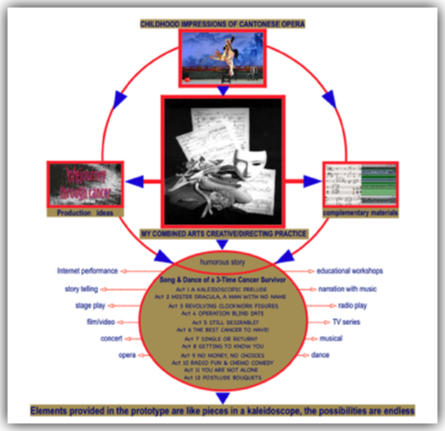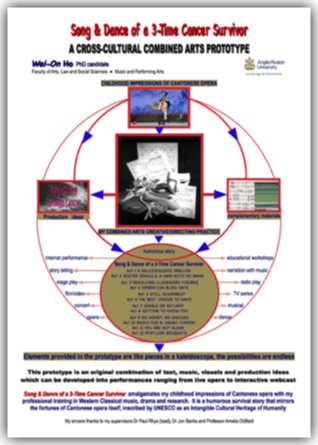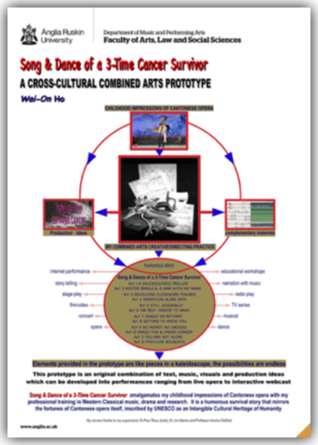My creative autobiographical PhD
Song & Dance of a 3-Time Cancer Survivor
for multi-venue performance and as a basis for new versions
Teaser excerpts at the bottom of this page
我的博士論文的核心是以粤劇概念来創作一英文曲本,这曲本可作消閒閲讀,亦可用來作多元化演出的脚本。我一直有心作點粤劇与西方歌劇相關的研究,多年來英國很多大學都說這是不可為的。學術界思想隨著時間進步,终於得償所願,我這個研究項目還得了個奬,但做研究生的過程也真曲折困難。這是在英国颁发的博士學位,論文要用英文寫,但我亦加插了一些中文段落,和很多相關的照片。全英國与粤劇有關的博士論文很少,希望我的努力能引發一些注意吧。
Or open from DropBox (may load faster)
Scores for “Song & Dance of a Cancer Survivor”:
Click "Thesis in PDF format" and go to Chapter 5 (PDF file from p.229, i.e., thesis p.213)
Click Comments to see feedback.
For John David Morley's (English novelist) response and critical comments on my creative autobiographical PhD, see J D Morley to Me pages.
Teaser excerpts at end of Introduction
INTRODUCTION TO MY THESIS
I have lived most of my life in the UK. Providence decreed that I am married to Western Classical music, but as a small child in Hong Kong, my first love was Cantonese opera that reached the lower classes, including those shunned by society – the poor, the illiterate, beggars, prostitutes, gangsters… bringing them enjoyment and culture, and I lived among these people as a child. Dante used his memory of his first love Beatrice as creative inspiration. I also use my memory of this first love as creative and staging inspiration while the art form is facing possible demise.
I wanted to write a PhD in storytelling style that can be enjoyed by the general public. University regulations demand inclusion of research and academic writing. However, the creative core Song & Dance of a 3-Time Cancer Survivor, a humorous story in 12 acts is not in academic English (e.g. its title), and I kept to storytelling throughout my thesis as much as possible.
The Cantonese opera that I remember was at its most cross-cultural and multimedia – anything goes for survival. The basis of 'big drama' (i.e., Cantonese opera) was a Quben 曲本 (pronounced chuben: u as German ü; en as in happen) – quasi libretto cum script that was also the basis for new versions. The music was a selection of existing tunes that performers had freedom to modify. A lead performer had a say in all performance aspects of his/her troupe. Performance could be unrehearsed, with ad-lib and changes on the spur of the moment. Many performers had a talent to interact with the audience, stepping in and out of the drama in live performance.
I therefore supplied a Quben in 12 acts with original music that can be played as written but with room for expansion, and production ideas based on my expertise… a reservoir of materials allowing free use and modification by others. I especially hope that creative performers and people who do not have the opportunity to receive professional training would make use of my PhD. The humorous Song & Dance is a good read on its own. My thesis is also a narrative of things disappearing that are not well documented, and my encounter with well-known people and those who were less respected in society.
This project helped me understand why I instinctively write music in a certain way, my venturing into electro-acoustic music, my proclivity for cross-cultural combined arts, and directing and designing my projects. My ultimate aim is to realize the Quben as an Internet opera.
TEASER EXCERPTS 以下一些博士論文片段:
A BEGGAR BOY 我的乞兒仔朋友 (見博士論文第三章)
(When I was about ten) While roaming free on the streets I befriended a beggar boy about my age. He sometimes put his hand into my jacket pocket to see if there was anything there for him. He was unusual because he was Eurasian. In colonial Hong Kong, ethnic Europeans were usually well off and occupied good positions. They did not mix with local Chinese much, let alone beggars... I sometimes saw a pregnant woman begging on a nearby street. The beggar boy told me that she was his mother. He told me that all his relatives were beggars, though they never acknowledged one other on the street... He never mentioned his father. Perhaps his mother worked as a prostitute, and the boy was the issue of a drunken GI or marine, commonly seen on the streets when their ship visited Hong Kong. To be the son of a beggar woman who also prostituted to gwai-lou 鬼佬 or devil men – the Cantonese term for Westerners – would make my friend the lowest of those shunned by society. Yet he knew Cantonese opera via the omnipresent radio broadcasts, the open-air shen-gong 神功戲 and other street performances accessible to all. (See PDF file Chapter 3 Cantonese Opera 3.2.1 (iii) Playmates, And A Beggar Boy, p.95, i.e. thesis p.79)
我大約十歲時在街上認識了一位和我年齡相仿的乞兒仔,他有點特別,因為是歐亞混血兒,那時候是英國殖民地的香港,歐裔的人通常都不窮和有好職位,也不怎樣和華裔港人混合交往,更不會和乞丐打交道的。我在街上有時見到一大肚女人乞錢,乞兒仔告訴我那女人是他的母親,又說他的親戚都是乞丐,但彼此在街上不打招呼的,他從來不講他的父親,可能他父親是位在美國軍艦泊港時,上岸喝醉酒在街上找賣淫女人的美國兵吧。我這位乞兒仔朋友是乞丐女人和鬼佬生的,一定受到岐視,被目為社會最低層,但這並不阻礙他一樣可以常常在街上聽粵曲和看到神功戲。
YOU ARE NOT ALONE 你並不孤單 (見博士論文第五章)
病中沒見到朋友、好友、老友和曾説過愛我的,但若我活下來好起來,這些人會見我的...
你並不孤單,快快好起來,在這苦難中,你有新朋友,仁慈幫助你...
Heroine:
I sustain a smile in company,
my demeanour is courageous,
my condition, not contagious,
yet you who spoke of love have flown,
I am left to groan and moan,
alone, all alone...
(from Act 11, Heroine's Song, Verse 4 – PDF file p.386, i.e. thesis p.370)
Chorus:
You are not alone.
Survive and be well.
In your journey through cancer,
you meet new people,
who are kind and helpful...
When you are well again,
you will see friends, old friends and good friends again,
and those who spoke of love...
(See PDF file Chapter 5, Act 11, p.387, i.e. thesis p.371)
OPERATION BLIND DATE 互不相識的男女的手術約會 (見博士論文第五章)
這是真光同學蔡美珠看了以下英文段落後寫的 (請看《相思苦》《山查子》《声声慢》和《月下獨酌》我與蔡美珠音樂視頻)
用互不相識的男女的約會來諷喻女主角之被送上手術台,很酷(cool)呢!預約臨窗的不是餐桌,卻是冰冷的手術台,期盼對方的出現變成緊繃的懸念,空腹的等待,無味的藥丸……;雞尾酒、香奈兒五號香水的概念反諷着手術前的除垢、消毒和強力的麻醉劑。外科醫師穿上白淨無瑕的制服,病者穿上藍色手術服~~展現着女體要被切割的部位,是何等荒誕的親密;沒有柔和的燈光,只有刺目的強光;最後,病者在白晝醒來,看見朋友在床沿放了一束鮮花和相片。(該是隱喻友情的可貴和重聚的喜悦吧?)
Surgeon (smile benignly):
We have a date at an operating table for two –
by the window.
Heroine:
This is a blind date –
an NHS patient cannot be sure of which surgeon.
But at least please don’t be late -
you doctors are so used to being late!
You can’t keep time.
You would never make it as musicians!
There is this “Nil by Mouth” sign hung high above my bed.
Nurses/chorus:
Nil by mouth -
nothing but a tiny, tasteless pill, by mouth.
Though you wilt and plead starvation -
it is still, Nil, by Mouth.
Heroine:
I am to be emptied inside out.
What a preparation for this blind date!
Nurses/chorus:
We prepare ourselves – ‘scrubbing up’.
You have a pre-med ‘cocktail’ beforehand.
Heroine:
Not wearing Chanel No 5,
but some potent antiseptic for our date!
Anaesthetist: (with gestures like a magician)
I will put you under my spell – anaesthetic.
Nurse: (with anxiety)
The patient has already had anaesthetic -
she’s nearly unconscious,
but the surgeon is still not here!
Heroine: (mumbling, worried)
I am still conscious –
I can hear you!
Where the hell is he, the surgeon, my date?!
Surely he won’t be so late,
that I’d come to in the middle of the op?!
Surgeon: (rushes in, cocksure of himself)
Eh, dress-code,
I am spick and span, wearing a dashing white suit.
Heroine:
I have a blue gown –
With a fine cut – exposing the part.
Chorus:
What sinister intimacy!
Sinister intimacy!
Heroine:
No soft lights this date of ours
but blinding bright ones.
When I wake in the morning
Will I have flowers by the bed?
Chorus:
When you wake you will look like an octopus
with tubes like arms, extending from your body -
the aftermath of this intimacy!
Heroin’s final speech:
Surprise, surprise!
When I wake
there are flowers from unexpected visitors –
while I was still in a blissful sleep,
a friend has placed photos on my bedside table
for me to see faces that I know when I come to.
(See PDF file Chapter 5, Act 4, p.278-280, i.e. thesis p.262-264)
THE LIVING TRADITION 活的傳統 (見博士論文第二章)
In 1988, London’s Victoria and Albert Museum advertised in the press, inviting innovative proposals for ‘Special Events’ to take place in the museum. In response I wrote a proposal entitled The Living Tradition, which called for the performance of new works based around images of museum exhibits and involving many creative and performing artists with whom I had worked. The proposal was initially accepted, but as the project developed the V&A official in charge felt uneasy about the ‘creative’ and ‘living’ aspects of the project. I had to answer to repeated queries: Would the relationship between the creative work and the image be historically correct, and in what way would the relationship between the creative work and the image have educational value? The official seemed not to understand that the project would use images of the past as creative/performative inspiration. Creative and performing artists are different from museum curators in that imagination and originality take precedence over historical accuracy or factual research; and creativity has a value of its own. In the end the V&A cancelled the project. However my group Inter Artes performed The Living Tradition at London’s Bloomsbury Theatre on 6th May 1989, in a version for soprano, dancers, three instrumentalists and multi-slide projection of images of V&A exhibits. A later version of the work was performed at the Hong Kong City Hall Concert Hall in 1991, with images from local museums. Even when writing a historical novel or directing a performance of historical drama, though the writer/producer will undertake a certain amount of research, authentic historical details alone cannot ensure the success of the work – ultimately it is the drama that matters. My PhD project is similar to The Living Tradition – its purpose is to create a performative work inspired by Cantonese opera at a time when the art form is in danger of becoming a lifeless museum exhibit.
(See PDF file Chapter 2 Research Context & Method 2.2.2 The Living Tradition pp.62-63, i.e. thesis pp.46-47)
見倫敦的維多利亞與艾伯特博物館(V&A)在各大報章刊登徵求在館內作“創新特別活動”的提案。我寫了以博物館展品圖像為靈感的創意藝術演出《活的傳统》提案,被接受了。项目發展過程中,博物館官方對項目的“創意”和“活”感到不安。問了一遍又一遍:圖像的應用是否歷史正確和具有教育價值?這位“官”似乎不明白這是有想像力原創性的藝術演出,不是攪展覽會,價值在於展品的形像活起來,引發思考和欣賞,這位“官”取消了演出。但《活的傳统》由我成立的《通藝》在倫敦的布盧姆斯伯里剧院,以歌者舞者和音樂配合V&A展品型象的幻燈投射演出,和在香港大會堂音樂廳與城市當代舞蹈團合作演出。我的博士論文類似“活的傳统”,冀望我童年接觸到的香港粵劇,以藝術形式而不是毫無生氣的博物館展覽品存活下來。
Song & Dance of a 3-Time Cancer Survivor - the core of my creative PhD - is a humorous read. Click the blue title to enter. Related music videos
HONG KONG WOULD SINK TO THE BOTTOM OF THE SEA 香港陸沉
During my childhood, Hong Kong was divided into three main areas: the city – Hong Kong Island and Kowloon Peninsula; the villages – the New Territories with old world charm, where villagers still cultivated fields in primitive ways; and many less populated or uninhabited offshore islands. From time to time I stayed in a village for short periods. In the early evenings, elderly villagers relaxed in a small open-air flat area surrounded by stones, telling stories of the past. An old and illiterate village woman once told me a legend about a tiny turtle crawling slowly on the seabed around the outer circumference of Hong Kong: when it finally completed the full circle Hong Kong would sink to the bottom of the sea. Perhaps the legend could be interpreted as a metaphor for the fast change and disappearance of many aspects of Hong Kong culture, in the absence of an oral tradition to pass them on. This PhD thesis is a narrative of things disappearing, and a creative intervention that enables them to continue in a new form rather than sinking to the bottom of the sea.
(See PDF file Chapter 1 Project Background and Metamorphosis, p.38, i.e. thesis p.22.)
小時候曾在香港新界沙田大圍村小住,黃昏時常在地堂聽老人家們講故事,記得有一位老婆婆她說有一只極小的海龜在海底慢慢地沿著香港的邊緣爬行,當爬行滿一圈回到起點時,香港便會陸沉。這傳說或可被解釋為香港文化快速變化和消失的隱喻,我這博士論文有一目的是寫下一些我曾親歷的,却面臨改變或消失的香港文化,用來做創作靈感,讓這些以藝術的型式存活下來 (見博士論文第一章)。
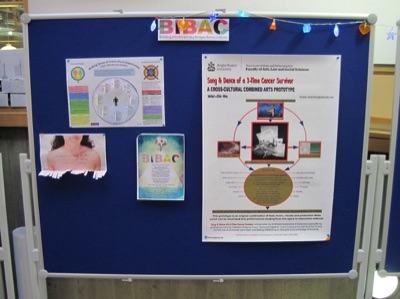
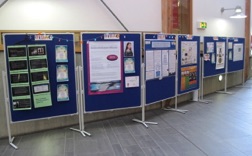
以上設計可以用來做海報在劍橋大學和其他大學或在世界性研討會時展覽
STOCKHAUSEN 史托候生 (見博士論文第四章)
In the Seventies, I attended a students' performance at the Royal Academy of Music of Stockhausen's Aus den Sieben Tagen (1968), which allows free improvisation by musicians to the text compositions unrehearsed. At this performance, for the words 'Play a vibration in the rhythm of the universe', one ensemble member hit something on stage with a stick hard (the stick broke); another shook a glass jar with beads inside very vigorously (the jar broke); the pianist kept playing double trills with both hands... The audience became very engaged in what was happening on stage, and the then RAM principal Sir Anthony Lewis (1915-1983) looked happy and laughed. In the RAM performance it would have worked had the charismatic Stockhausen been present. In the Cantonese opera of my childhood, some performers flexibly modified the words of the Quben (libretto cum script), and adlibbed with words and movements unrehearsed. I treasured what I saw because it was a ‘one-off’. Cantonese opera da-lao-guan 大佬倌 (superstar lead performer) could make it work and the performance stayed in the audience's memory. Even when it did not work, some lead performers could step out of the drama to communicate directly with the audience who loved them and could get away with it. As Cantonese opera dwindles over the years, with less new blood that can reach the status of da-lao-guan, a less charismatic performer doing this may be more like a farce, making people to look down and dismiss this Cantonese opera characteristic.
(See PDF file Chapter 4 My Cross-Cultural Combined Arts Prototype 4.1.7 Cantonese Opera pp.190-91 i.e., thesis pp.174-5)
英國皇家音樂學院學生音樂會演出著名電子音樂作曲家史托候生的一首名作,要演出者即興演出他寫的一些句子,到"奏出宇宙節奏的震動"這句時,學生們即興演繹得太興奮了,台上一片混亂,有點好笑,但如果非常有魅力的史托候生在場,這演出將會是感人的。這讓我想起小時候粵劇的"香港唔排戲",大佬倌憑個人魅力和舞台經驗可以不排練便上台演出,又能對曲詞自由發揮及爆肚,可惜這些才能已失傳和被輕視。
QUBEN Song & Dance of a 3-Time Cancer Survivor 曲本《歌舞慶重生》
Quben 曲本, is pronounced: chuben – u, like the German ü; en as in happen. I canot find a Western equivalence – the closest to describe it might be quasi libretto cum script. Though a Quben contains the words to be sung, a composer plays no part in it, let alone like Mozart and Da Ponte working closely together: and it is Mozart rather than Da Ponte's libretto that takes the credit of Le Nozze di Figaro and Don Giovanni; whereas with Tang Xianzu 湯顯祖 (1550-1616) it is his Quben that is the drama The Peony Pavilion 牡丹亭... As creative writing affected by chosen tunes, John Gay's The Beggar's Opera of 1728 is perhaps the closest to the concept of a Cantonese opera Quben... Although The Beggar's Opera has been studied by scholars, the words are not detached from the music and hailed as a piece of great literature like The Peony Pavilion. In fact, Shakespeare's plays with their beautiful and stylized writing are closer to some of the best Qubens, but Shakespeare is not written for the purpose of singing the words from beginning to end, nor is it affected by the sound of some chosen melodies...
I therefore decided on writing a Quben, to be exact, a quasi-Quben in English as inspired by the concept of Cantonese opera to be the main part of my cross-cultural combined arts prototype (i.e., the core of my creative PhD). I used my cancer survival as the story for the drama, as this suits the semi-autobiographical nature of the project: it links with my concern for the survival of Cantonese opera, and the writing is with humour to lighten up what might otherwise seem gruesome to some people. The title of my Quben is Song & Dance of a 3-Time Cancer Survivor. Many Cantonese operas and Cantonese films of my childhood had long titles telling the unsophisticated audience what the story is all about – what you see is what you get; Song & Dance implies self-mocking with humour; and why 3-Time instead of Three-Time? This is how a Hong Kong Cantonese would write it, and it is also more eye-catching and fits the small screen of the Internet better.
(See PDF file Chapter 4 My Cross-Cultural Combined Arts Prototype 4.2.2 The Concept of a Quben pp.195-7 i,e., thesis pp.179-181)
我小時候在香港看的大戲(粤劇),英譯為廣東歌劇,但創作、結構和概念等等,都與西方歌劇大異,西方歌劇就是作曲家個人風格的原創音樂,曲詞無論多好都是次要,觀眾未必留意記得,粵劇却是撰曲人從已存在的音樂中,根據劇情挑選和組合適用的曲調旋律或小曲,列出曲名填寫優美曲詞,和像劇本那樣寫動作提示,這種曲本是戲的根據,中國傳統戲曲有些曲本的曲詞,如湯顯祖《牡丹亭》,已脫離音樂成為文學。撰曲人亦間有加入少許自己作的曲,但這並非必要,選用的旋律和小曲,會因為文字、劇情和老倌唱腔而畧有改變,有些撰曲人在曲詞旁注寫每個字的唱音和節拍及過門奏法,但演出者仍有很多演繹和再創造的空間,现在大陸的唱腔設計人,用簡譜寫出怎樣唱和樂器怎樣奏並加上自己寫的連接片段,但仍是把大部份都是流傳下來的音樂畧加變化的工作,從西方古典音樂的概念而論,屬於改編音樂,不屬於西方歌劇全是一位作曲家作的原創音樂。在1728年英國有《乞丐歌劇》,组合一些觀眾熟悉的歌曲另寫歌詞來演戲,概念上最像粤劇了,但曲詞不算優美,莎劇文字優美如曲本,却非曲詞...我小時看的大戲包含當時當地方言和俚俗文化,很多特點在今天香港已不留存,西方人更無法領會,我最早接觸的音樂和演出是香港粵劇粵曲,我本科是西方古典音樂,又長居英國,很自然我從事跨文化創作,博士論文第五章我以曲本概念和自身經歷用英文寫《歌舞慶重生》,直譯是《三次癌存活者的歌舞》,又提供音樂和把這英文曲本作不同型式演出的材料,論文其他各章是相關的文化背景和研究,希望能夠把一些粵劇概念和演出特點留存,見用啟發西方。(見博士論文第四章)
SHEN-GONG PERFORMANCE 神功戲 (見博士論文第三和第六章)
(During my childhood) Cantonese opera was part of daily life for the masses of Hong Kong via omnipresent radio broadcasts, music making of the lower classes, accessible live performances in the theatre, and open-air shen-gong performances. Children’s early exposure resulted in diehard fans and performers... Shen-gong 神功, literally god-reward, is open-air performance on a temporary stage, which traditionally serves as thanksgiving and asking for god’s blessing. I understood no religious significance in the shen-gong performances I witnessed as a child, rather they served as festivities where people gathered to have a good time. Due to the temporary stage and other arrangements, shen-gong performance was flexible, and served as a hothouse for developing improvisatory skills and adlibbing... Even a beggar boy and his relatives, after hearing, seeing and enjoying Cantonese opera performances in the markets, or at shen-gong performances were able to sing and play what they remembered.
(See PDF file Chapter 3 Cantonese Opera 3.2.3 Overview of Remembering p.108 i.e., thesis p.92; 3.4.6 (iii) Shen-Gong Performance, p.126, i.e. thesis p.112, and Chapter 6 Conclusion 6.1.3 Reconnecting with Humble Origin p.421 i.e., thesis pp.405-6)
我小時候的香港,粵曲和大戲是很多市民,尤其是贫苦大眾日常生活的一部分,到處都可聽到收音機 (電台)播粵曲和大戲片段,除了去戲院睇大戲(看粤劇),有些茶樓酒館,甚至街上也會見到業餘演出,戲行收入頗依靠神功戲。這種臨時搭棚部分露天演出的神功戲,雖說酬神祈福,其實更像喜慶節日大家一起高高興興的,什麼人都可以看,也不用買票,趁人多來乞討的也可以在棚外看,也有記得聽到的粵曲会唱幾句來乞錢。神功戲演出比較有活動性,頗能發揮香港唔排戲和爆肚即興演出這一些當時粵劇的特點。
CONCLUSIONS 結論 (見博士論文第六章)
Having grown up in Hong Kong, a British colony of mixed Chinese and Western culture, and living the rest of my life in the UK as a racial minority, it is understandable that my work has a tendency towards the cross-cultural. Since 1974 when my work first started to receive public performances, I noticed that cross-cultural work in the UK, especially by those of racial minority, is often misunderstood as being ethnic and intended just for the racial minority, and as if all minorities are the same. Though I am professionally trained in Western Classical music and much of my creative practice has been according to Western principles, the Arts Council of the UK asked me to be an external assessor of Indian music and dance performances. I have neither training nor knowledge of Indian culture; my only credential appears to have been that I am of ethnic minority... Long ago I suggested to the then BBC Controller the idea of presenting a one-off programme on cross-cultural music. I was told never, rather than no. Unless there is a wider perception of cross-cultural arts, life will be difficult for those with talents and expertise in this field, wasting their time and talents. It is understandably difficult to recognise or define work as being cross-cultural, since the possible cultural combinations are endless. But I believe it will do the world good to have more cross-cultural work and to look at things from the middle ground. Perhaps in the future there will be fewer unwise policies that bring about much misery. At least the world will be a richer place due to so many new cultural combinations...
My thesis and prototype explain Cantonese opera in a way that Westerners can understand; they also provide a record of what was passing and might not be known in the future. Cantonese opera is facing possible demise; at least those characteristics that were held dear by me and by the masses of Hong Kong in the 1950s and 60s seem unlikely to be practiced in the future. My PhD is an attempt to retain these characteristics in a new format that can be understood by Westerners and enjoyed by the general public, in the same way that Cantonese opera was enjoyed by even the lowest strata of society during my childhood. Western Classical music has a well-preserved history of different periods. Even music of the distant past, such as Gregorian chant, is still studied and performed by specialists. But the recent past of Cantonese opera, with its emphasis on the individuality of performers and their creativity, has been forgotten by younger generations. What I remember might add a piece to the incomplete picture. With the Chinese government enforcing Putonghua, even the Cantonese language in Canton province may be endangered, let alone the transient Hong Kong Cantonese culture of which Cantonese opera was once an important part.
(See PDF file Chapter 6 Conclusions 6.1.4 Importance of the Cross-Cultural p.422 i.e., thesis p.406; 6.2.3 For Cantonese Opera and Hong Kong Cantonese Culture p.425, i.e. thesis p.409)
我在融合中西文化的香港成長,却長居英國,作品傾向跨文化。我注意到英國少數族裔若從事跨文化工作,常被誤認為只是做給少數族裔看,有些英國人把少數族裔看成都是一樣的,譬如我本科是西方古典音樂,英國藝術局卻派我做印度音樂和舞蹈表演的評審員...我曾向BBC建議做跨文化音樂節目,却被告知永不可能。太少人對跨文化藝術有認識了,很多在這領域有才華和專業的人被浪費。或説很難對跨文化理解和定義,因為文化組合是無止境的,但我相信,跨文化工作對世界好,若能從中間立場審視事物,會少些不明智的政策,眾多的文化組合也會使世界更豐富。
西方古典音樂對不同時期的作品有保存完好的歷史,即使古遠如格里高利聖歌,仍有專家研究和演奏。粵劇瀕危,我小時候能令社會最底層的人都喜愛的粵劇粵曲,很多特徵不被珍視已被年輕一代遺忘,或不能重現了,中國政府的普通話政策,廣東話也難保,更何況香港廣東文化呢?我的博士論文以西方人能理解的方式解釋我所知道的,曾是香港文化一部分的粵劇,記錄了一些或會被遺忘的過去,以新形式的創作和演出保存我記憶中粵劇的美好,像在粤劇這不完整的圖片上添補一小塊,使西方人亦可理解用來作靈感創造大眾喜愛的藝術和演出。
Click to enlarge my following designs explaining the multimedia nature of my creative PhD and as a prototype for multi-venue performance.
點擊以下放大我的設計用來解釋我這創作性的博士論文及其各種演出型式
Lower down: PhD thesis in PDF format, related folder, comments, introduction and teaser excerpts etc.
再下面是論文簡述,全文和相關資料的 PDF 及論文片段
The above design used as PhD poster displayed at BIBAC International Conference which was held at Cambridge University.
